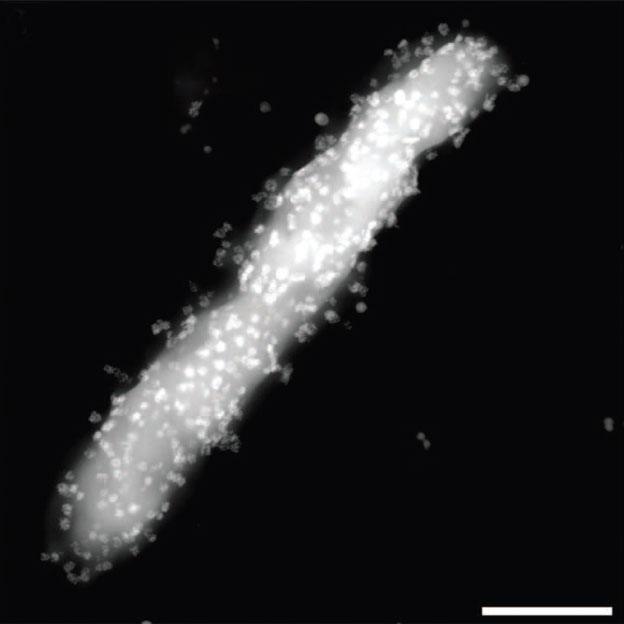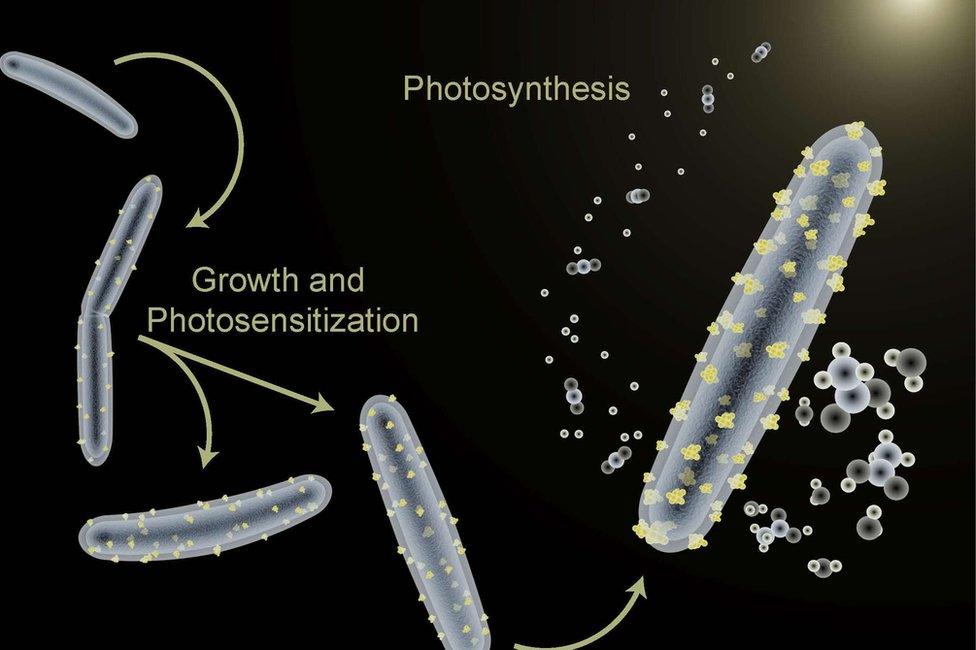'Cyborg' bacteria deliver green fuel source from sunlight
- Published

Scientists have grown bacteria covered in tiny solar panels made from cadmium sulphide
Scientists have created bacteria covered in tiny semiconductors that generate a potential fuel source from sunlight, carbon dioxide and water.
The so-called "cyborg" bugs produce acetic acid, a chemical that can then be turned into fuel and plastic.
In lab experiments, the bacteria proved much more efficient at harvesting sunlight than plants.
The work was presented at the American Chemical Society meeting, external in Washington.
Researchers have been attempting to artificially replicate photosynthesis for many years.
Solar panel bugs
In nature, the green pigment chlorophyll is key to this process, helping plants to convert carbon dioxide and water, using sunlight, into oxygen and glucose.
But despite the fact that it works, scientists say the process is relatively inefficient. This has also been a big problem with most of the artificial systems developed to date.
This new approach seeks to improve that efficiency by essentially aiming to equip bacteria with solar panels.
After combing through old microbiology literature, researchers realised that some bugs have a natural defence to cadmium, mercury or lead that lets them turn the heavy metal into a sulphide which the bacteria express as a tiny, crystal semiconductor on their surfaces.
"It's shamefully simple, we've harnessed a natural ability of these bacteria that had never been looked at through this lens," said Dr Kelsey Sakimoto from Harvard University in Massachusetts, US.
"We grow them and we introduce a small amount of cadmium, and naturally they produce cadmium sulphide crystals which then agglomerate on the outsides of their bodies."

The bacteria are said to be more efficient than plants at producing useful materials from sunlight
"You grow them in their liquid broth and you just add small aliquots of cadmium solution and you wait a couple of days and out pops these photosynthetic organisms.
"It's all very simple, mix-in-a-pot-chemistry."
These newly boosted bacteria produce acetic acid, essentially vinegar, from CO2, water and light. They have an efficiency of around 80%, which is four times the level of commercial solar panels, and more than six times the level of chlorophyll.
"We prize these cyborg bacteria and their ability to make acetate because they produce a substrate that we can already use to produce more valuable and more interesting products," said Dr Sakimoto.
"We have collaborators who have a number of strands of E. coli that are genetically engineered to take acetic acid as their food source and they can upgrade it into butanol and a polymer called polyhydroxybutyrate."
Soaking in the Sun
Dr Sakimoto believes that these bacteria offer some advantages over other approaches to generating green energy from biological sources.
Other techniques for artificial photosynthesis require expensive solid electrodes.
The cyborg bug approach really only needs large vats of liquid to be kept out in the Sun - the bacteria are self-replicating and self-regenerating, making it potentially a low waste technology. It might work best in rural areas or in the developing world.
The research work was carried out at the University of California, Berkeley in the lab of Dr Peidong Yang.
"The thrust of research in my lab is to essentially 'supercharge' non-photosynthetic bacteria by providing them energy in the form of electrons from inorganic semiconductors, like cadmium sulphide, that are efficient light absorbers," Dr Yang said.
"We are now looking for more benign light absorbers than cadmium sulphide to provide bacteria with energy from light."
The researchers believe that while their approach has taken an important new step, it might not ultimately be the technology that prevails.
"There are so many different designs of these systems coming out and really we've only begun to explore the different ways we can combine chemistry and biology," said Dr Sakimoto.
"And there's a real possibility that that there will be some upstart technology that will come out that will do better than our system."
Follow Matt on Twitter, external and on Facebook, external.